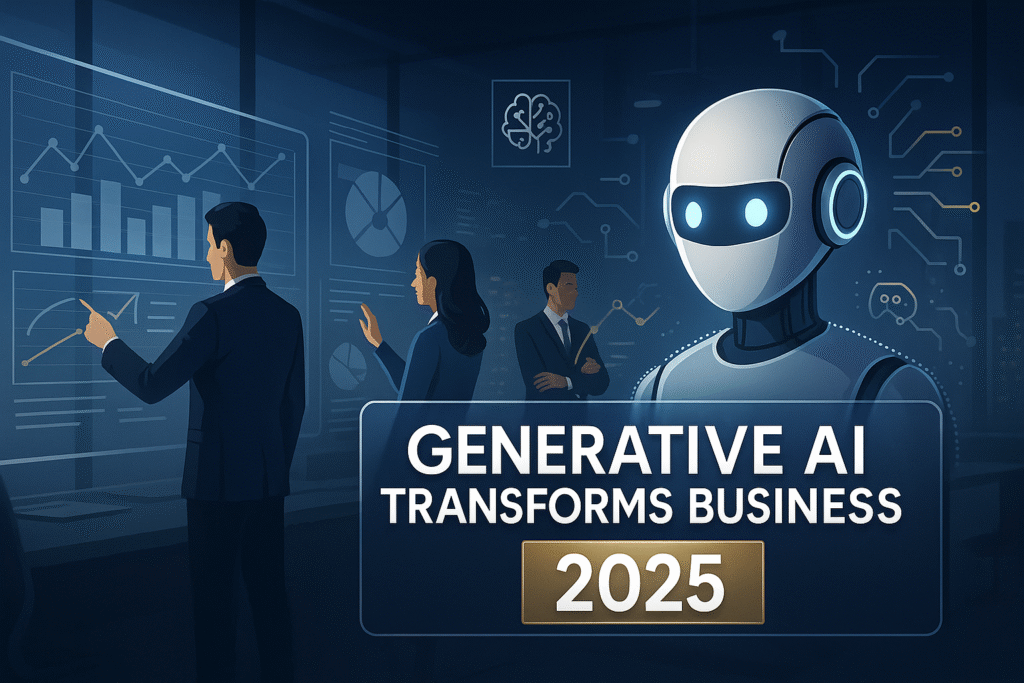How Generative AI Is Boosting Business Productivity in 2025

How Generative AI Is Boosting Business Productivity in 2025
Generative AI is no longer the next big thing—it’s the heartbeat of modern business. According to Google Trends, interest in “generative AI” continues to surge as companies across industries harness AI agents to streamline tasks, enhance decision-making, and drive innovation. Let’s explore how this technology empowers enterprises, supported by expert insights from sources like Exploding Topics and Google Cloud.
Why Generative AI Holds Center Stage
In 2025, generative AI isn’t just about creativity—it’s a productivity powerhouse. As highlighted by Exploding Topics, “Generative AI Boosts Business Productivity” is one of the top trends to watch in both 2025 and 2026 :contentReference[oaicite:1]{index=1}. Companies are adopting AI agents—smart systems capable of automating workflows, handling communications, and analyzing data—making them essential tools rather than optional enhancements.
What Are AI Agents and Why They Matter
Unlike traditional automation, AI agents act like “Chief Simplifier Officers,” as described by Google Cloud. These intelligent systems process text, audio, images, and video to manage complex workflows—from scheduling and email triage to generating reports and summarizing meetings :contentReference[oaicite:2]{index=2}.
Multimodal Intelligence in Action
For example, customer support teams now use AI that listens to calls, provides smart prompts, and drafts responses in real time. Meanwhile, marketing departments rely on multimodal AI to analyze campaign performance, customer sentiment, and trend shifts—all from one dashboard.
Real-World Gains: Efficiency, Accuracy, Speed
Businesses implementing generative AI report impressive improvements:
- Efficiency: Automated routine tasks free up teams for strategic work.
- Accuracy: AI agents reduce manual errors in data-heavy processes.
- Speed: Quick generation of content, reports, and insights enhances responsiveness.
These gains are not hypothetical—they’re already shifting internal operations across sectors.
Who’s Leading the Charge?
Organizations across the globe are racing to integrate generative AI:
- Google Enterprise Tools: With multimodal AI, Google enables enterprises to run image, text, and video queries within internal searches :contentReference[oaicite:3]{index=3}.
- Retail Innovators: Brands like Kingfisher (owner of B&Q and Screwfix) have built AI agents that merge customer data and voice search to enhance service :contentReference[oaicite:4]{index=4}.
- Financial Institutions: Banks use generative AI to distill market analysis into client briefs, enabling faster and more informed decisions.
Challenges on the Road Ahead
Despite the promise, adoption isn’t without hurdles:
- Data Privacy: Secure handling of sensitive corporate and customer data is paramount.
- Skill Gaps: Staff need AI training, while CIOs must ensure ethical and bias‑free algorithms.
- Return on Investment: Measuring productivity gains accurately remains a challenge.
Strategies for Success
To harness generative AI effectively, businesses should:
- Audit processes to identify high-impact, repetitive tasks.
- Invest in multimodal AI platforms that align with existing systems.
- Train employees and establish ethical guidelines for AI output.
- Track productivity metrics—like time saved, error reduction, and customer satisfaction.
The Bigger Picture
Generative AI isn’t just improving operations—it’s transforming business models. Firms are reimagining entire workflows around AI agents, blurring the line between digital assistants and strategic leaders. As Exploding Topics mentioned, this trend extends into 2026 and beyond :contentReference[oaicite:5]{index=5}.
What’s Next?
- Deeper integration with IoT and 5G to create real-time, intelligent environments.
- Expansion of AI agents into creative fields, like design, music, and multimedia.
- Global push toward sovereign AI—countries developing proprietary models for economic and digital sovereignty.
Conclusion
In 2025, generative AI has evolved from a buzzword into a business imperative. Companies that integrate AI agents thoughtfully—supporting employees, safeguarding data, and setting clear metrics—are gaining a competitive edge. As this trend continues to grow into 2026, it’s clear that AI-driven productivity is the future of modern business.
Frequently Asked Questions (FAQs)
Q1: What is a generative AI agent?
An AI agent is a multimodal system (handling text, audio, images, video) that autonomously executes tasks like scheduling, drafting, sourcing data, and summarizing content to streamline workflows.
Q2: Are AI agents replacing human jobs?
They aim to automate repetitive tasks—not replace humans. In fact, employees often shift to higher-value roles, like strategy or creativity, as AI handles routine duties.
Q3: How can small businesses adopt generative AI affordably?
Start with cloud-based AI tools that offer modular subscriptions. Begin with specific use cases—e.g., automating social media posts—then scale as ROI becomes clear.